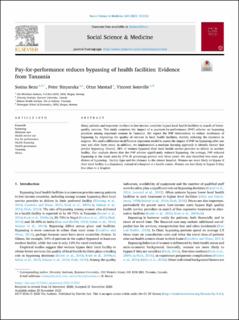| dc.contributor.author | Chiksa, Sosina Bezu | |
| dc.contributor.author | Binyaruka, Peter John | |
| dc.contributor.author | Mæstad, Ottar | |
| dc.contributor.author | Somville, Vincent | |
| dc.date.accessioned | 2020-12-22T09:53:43Z | |
| dc.date.available | 2020-12-22T09:53:43Z | |
| dc.date.created | 2020-11-25T21:01:17Z | |
| dc.date.issued | 2020 | |
| dc.identifier.issn | 0277-9536 | |
| dc.identifier.uri | https://hdl.handle.net/11250/2720728 | |
| dc.description.abstract | Many patients and expectant mothers in low-income countries bypass local health facilities in search of betterquality services. This study examines the impact of a payment-for-performance (P4P) scheme on bypassing
practices among expectant women in Tanzania. We expect the P4P intervention to reduce incidences of
bypassing by improving the quality of services in local health facilities, thereby reducing the incentive to
migrate. We used a difference-in-difference regression model to assess the impact of P4P on bypassing after one
year and after three years. In addition, we implemented a machine learning approach to identify factors that
predict bypassing. Overall, 38% of women bypassed their local health service provider to deliver in another
facility. Our analysis shows that the P4P scheme significantly reduced bypassing. On average, P4P reduced
bypassing in the study area by 17% (8 percentage points) over three years. We also identified two main predictors of bypassing - facility type and the distance to the closest hospital. Women are more likely to bypass if
their local facility is a dispensary instead of a hospital or a health center. Women are less likely to bypass if they
live close to a hospital. | en_US |
| dc.language.iso | eng | en_US |
| dc.rights | Navngivelse 4.0 Internasjonal | * |
| dc.rights.uri | http://creativecommons.org/licenses/by/4.0/deed.no | * |
| dc.subject | bypassing | en_US |
| dc.subject | maternal care | en_US |
| dc.subject | health service use | en_US |
| dc.subject | pay for performance | en_US |
| dc.subject | health financing | en_US |
| dc.subject | health governance | en_US |
| dc.subject | Tanzania | en_US |
| dc.subject | Africa | en_US |
| dc.title | Pay-for-performance reduces bypassing of health facilities: evidence from Tanzania | en_US |
| dc.type | Peer reviewed | en_US |
| dc.type | Journal article | en_US |
| dc.description.version | publishedVersion | en_US |
| dc.source.journal | Social Science and Medicine | en_US |
| dc.identifier.doi | 10.1016/j.socscimed.2020.113551 | |
| dc.identifier.cristin | 1852515 | |
| cristin.ispublished | true | |
| cristin.fulltext | original | |
| cristin.qualitycode | 2 | |

